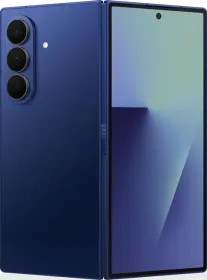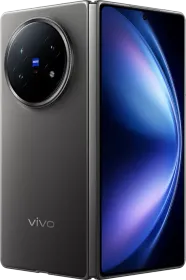Pixel 10 Pro Fold vs. Galaxy Z Fold 7: Table of Contents
There’s a new foldable in town: the Pixel 10 Pro Fold. It features everything that makes Google’s Pixel phones different from other Android phones. It takes it to another level with improvements like brighter screens, a more powerful chipset, a larger battery, and new AI smarts.
However, the phone has a similar price to the Galaxy Z Fold 7 (review), which puts it into direct competition with Samsung’s seventh-generation foldable. In today’s article, we’ll find out which foldable is better for you. So, without any further ado, let’s dive into one of the most detailed comparisons between the Pixel 10 Pro Fold and the Galaxy Z Fold 7 on the internet.
Pixel 10 Pro Fold vs. Galaxy Z Fold 7: Tech Specs
| Pixel 10 Pro Fold | Galaxy Z Fold 7 | |
| Colors | Moonstone, Jade | Blue Shadow, Silver Shadow, Jet Black, Mint |
| IP Rating | IP68 | IP48 |
| Display | Cover Screen: 6.4-inch Actua display Inner Screen: 8-inch Super Actua Flex | Cover Screen: 6.5-inch Dynamic LTPO AMOLED 2X Inner Screen: 8-inch Dynamic LTPO AMOLED 2x |
| Processor | Tensor G5 (3nm) | Snapdragon 8 Elite (3nm) |
| RAM + Storage | 16GB + 256GB | Up to 16GB + 1TB |
| Software | Android 16; 7 years of major OS updates | One UI 8.0; 7 years of major OS updates |
| Camera | Rear: 48MP + 10.5MP + 10.8MP Selfie (cover + inner): 10MP + 10MP | Rear: 200MP + 120MP + 10MP Selfie (cover + inner): 10MP + 10MP |
| Battery Capacity | 5,015 mAh | 4,400 mAh |
| Charging Speed | 30W | 25W |
| Starting Price | Rs. 1,72,999 | Rs. 1,72,999 |
Pixel 10 Pro Fold vs. Galaxy Z Fold 7: Design
Dimensions & Weight

| Pixel 10 Pro Fold | Galaxy Z Fold 7 | |
| Dimensions: Folded | 155.2 x 76.3 x 10.8 mm | 158.4 x 72.8 x 8.9 mm |
| Dimensions: Unfolded | 155.2 x 150.4 x 5.2 mm | 158.4 x 143.2 x 4.2 mm |
| Weight | 258 grams | 215 grams |
Between the foldables, Samsung’s Galaxy Z Fold 7 is thinner, both in the folded and the unfolded state. Further, it is 43 grams lighter than the Pixel 10 Pro Fold, creating a noticeable difference when they’re held in hand.
Materials
When it comes to materials, the Pixel 10 Pro Fold features the Gorilla Glass Victus 2 on the cover screen and the back panel (with a silky matte finish), an aerospace-grade aluminum frame, and multi-alloy steel, likely on the hinge cover. The inner screen, however, doesn’t seem to feature any protective glass layer.
The Galaxy Z Fold 7, in contrast, features the Gorilla Glass Ceramic 2 on the cover screen, while the Gorilla Glass Victus 2 is used in the back panel (with a matte finish). Like the Pixel Fold, the Galaxy Fold also sports an Armor Aluminum frame (also used on the phone’s hinge). However, the inner screen doesn’t have any protective covering.
Design

Both phones feature a strikingly different design. To begin with, the Pixel 10 Pro Fold has a more square-like form factor when unfolded, while the Galaxy Z Fold 7 is relatively taller and narrower.
The foldables feature a cover screen with a punch-hole display, but the one on the Fold 7 has noticeably thinner bezels than the Pixel Fold. On the inside, both phones feature a foldable screen that has chunky bezels with a different camera placement.
On the back panel, the Pixel 10 Pro Fold features a horizontally-aligned camera module wherein the three sensors are distributed in two different levels. However, the Fold 7 features a vertically placed module, wherein each sensor protrudes a bit.
Colors
Pixel 10 Pro Fold: Moonstone, Jade
Galaxy Z Fold 7: Blue Shadow, Silver Shadow, Jet Black, Mint
IP Rating
While the Galaxy Z Fold 7 features an IP48 dust and water resistance rating, the Pixel 10 Pro Fold is the first foldable (to my knowledge) to feature an official IP68 rating. This essentially bridges the gap between the dust and water resistance levels of regular and foldable smartphones.
Also Read: OnePlus 15 Leak: 165Hz Display for Gaming, But Cameras Take a Hit
Pixel 10 Pro Fold vs. Galaxy Z Fold 7: Display


Talking about the screens, the Pixel 10 Pro Fold features a 6.4-inch Actua display with a resolution of 2364 x 1080 pixels (408 ppi), variable refresh rate (60-120Hz), and a peak brightness of up to 3,000 nits (HDR brightness limited to 2,000 nits).
Unfolding the Pixel Fold, you’ll come across the 8-inch Super Actua Flex screen, which has a resolution of 2152 x 2079 pixels (373 ppi), supports variable refresh rate (1-120Hz), and can shine as bright as 3,000 nits (HDR brightness limited to 1,800 nits).
Both the outer and the inner screens support HDR content and 24-bit depth for 16 million colors.
In comparison, the Galaxy Z Fold 7 features a slightly bigger 6.5-inch Dynamic LTPO AMOLED 2X screen with a resolution of 2520 x 1080 pixels (422 ppi, sharper than the Pixel Fold), and a peak brightness of up to 2,600 nits (less than the Pixel 10 Pro Fold).
The Fold 7 also offers an 8-inch Dynamic LTPO AMOLED 2x foldable inner screen, with a resolution of 2184 x 1968 pixels (368 ppi, lower than Pixel Fold) and a peak brightness of 2,600 nits. Given that both screens feature an LTPO panel, they support variable refresh rate (1-120Hz).
Last but not least, the foldable screen on the Fold 7 supports HDR10+ content.
To sum up, the Pixel 10 Pro Fold offers a brighter outer screen, but the one on the Fold 7 is sharper and smoother. However, the inner screen on the Google Pixel Fold is both brighter and sharper.
Pixel 10 Pro Fold vs. Galaxy Z Fold 7: Performance

Google’s latest book-style foldable sports the Tensor G5 (3nm) processor, which features a 3.78 GHz prime core, five 3.05 GHz performance cores, and two 2.25 GHz efficient cores, which make up for a 1+5+2 cluster design, along with a Mali GPU, a capable TPU, 16GB of RAM, and 256GB of storage (the handset is available in a single storage variant in India, most likely with UFS 3.1 standard).
Early benchmarks also suggest that the Tensor G5 scores around 21% higher in single-core and 46% higher in multi-core CPU tests on the GeekBench 6 synthetic benchmark. The numbers are relative to what the Pixel 9 Pro Fold scored with the Tensor G4 SoC, suggesting that the latest foldable packs in a noticeable performance improvement.

Samsung’s Galaxy Z Fold 7, on the other hand, features the Snapdragon 8 Elite (3nm) processor, which features two 4.47 GHz prime cores, six 3.53 GHz performance cores, the Adreno 830 GPU, Qualcomm’s Hexagon NPU, 16GB of LPDDR5X RAM, and 1TB of UFS 4.0 storage.
With this configuration, the Galaxy Z Fold 7 scored 2,545/8,612 points in the single/multi-core GeekBench 6 CPU test, which is around 10% and 30% higher than what the Tensor G5 scores, respectively. Hence, it is safe to say that Google’s latest processor still has a lot of catching up to do with the Snapdragon 8 Elite.
With day-to-day tasks, you shouldn’t feel the difference in the performance. However, when you’re playing video games or editing videos, the Galaxy Z Fold 7 will come out on top.
Also Read: Qualcomm Snapdragon 8 Elite Launched: Specs, Features, and Upcoming Phones
Pixel 10 Pro Fold vs. Galaxy Z Fold 7: Operating System

Out of the box, the Pixel 10 Pro Fold runs on Google’s latest Android 16 operating system, which offers plenty of new features. For instance, the Pixel Fold gets Live Updates, which is Google’s take on Live Activities. Other additions include an improved adaptive refresh rate, a new photo picker API for third-party apps, a new predictive back button, and a few camera-related updates.
Like all the other Pixel 10 devices, the Pixel 10 Pro Fold will get seven years of major operating system and security updates, along with quarterly Pixel Drops. In addition to the regular features, the Pixel Fold includes new Gemini-powered camera features, such as Camera Coach and Edit with Ask Photos, along with a new Magic Cue feature that helps with personal insights from across Google apps.

Even though the Pixel 10 series is Google’s first smartphone lineup to come with Android 16, Samsung did it first. Its Fold 7 features One UI 8.0, which is based on Android 16. Among the new features are drag-and-drop between apps, a new split-screen view, and updates to Samsung’s system apps, such as My Files, Quick Share, Internet, Health, etc.
The Galaxy Z Fold 7 will also get seven years of major One UI and security updates. However, when it comes to AI-based features, the Galaxy AI suite offers plenty of options, including Live Translate, Note Assist, Transcript Assist, Chat Assist, Generative Edit, and so on.
Pixel 10 Pro Fold vs. Galaxy Z Fold 7: Optics


| Pixel 10 Pro Fold | Galaxy Z Fold 7 | |
| Primary Camera | 48MP (f/170, 1/2″, OIS) sensor | 200MP (f/1.7, 1/1.3″, OIS) sensor |
| Secondary Camera | 10.5MP (f/2.2, 127° FOV, 1/3.4″) ultrawide sensor with AF | 12MP (f/2.2, 120˚ FOV) ultrawide sensor with AF |
| Tertiary Camera | 10.8MP (f/3.1, 1/3.2″, OIS) telephoto camera; 5x optical zoom | 10MP (f/2.4, OIS) sensor with telephoto lens; 3x optical zoom |
| Selfie Camera (Cover Screen) | 10MP (f/2.2, 87° FOV) | 10MP (f/2.2, 24mm) |
| Selfie Camera (Inner Screen) | 10MP (f/2.2, 87° FOV) | 10MP (f/2.2, 18mm) |
Among the key features of the Pixel Fold’s camera system are Super Res Zoom (up to 20x), Pro Controls, Camera Coach (a new feature that helps improve the overall composition), Edit with Ask Photos (enables you to edit photos with voice commands), 4K video recording at up to 60 fps (from the rear and the front camera), Night Sight Video, 10-bit HDR capture, and Audio Zoom.
The Fold 7’s cameras allow you to zoom in up to 30x, provide manual controls, add new abilities to the Portrait Studio, refreshed filters, and let you use the new Audio Eraser feature. Regarding video, the foldable can go up to 8K video at up to 30 fps, 4K video at up to 120 fps, HDR10+ videos, and support log video recording.
Also Read: Vivo T4 Pro To Launch in India On August 26th
Pixel 10 Pro Fold vs. Galaxy Z Fold 7: Battery & Charging Rate


The Pixel 10 Pro Fold includes a 5,015 mAh battery that provides over 24 hours of usage time between charges and up to 84 hours with the Extreme Battery Saver mode. It supports fast charging, wherein a 30W USB-C PPS charger can charge the phone up to 50% in around 30 minutes. Last but not least, the phone supports Pixelsnap wireless charging (Qi2-certified).
The Fold 7 features a smaller 4,400 mAh battery that offers over six hours of screen-on time on our test. The phone supports 25W wired charging, 15W wireless charging (without magnets), and 4.5W reverse wireless charging.
Given that the Pixel 10 Pro Fold uses a 3nm processor and a larger battery, I’m inclined to say that it might last longer between charges.
Pixel 10 Pro Fold vs. Galaxy Z Fold 7: Connectivity Options
When it comes to connectivity options, the Pixel 10 Pro Fold provides 5G mmWave + Sub-6 GHz, Wi-Fi 7, Bluetooth v6.0, dual-band GPS, NFC, ultra-wideband for accurate ranging, and satellite connectivity. The phone also features a USB Type-C 3.2 port (similar to the Fold 7).
The Fold 7 also supports both 5G networks and Wi-Fi 7, but it features Bluetooth v5.4. Anyway, you get support for Wi-Fi 7, GPS, NFC, ultra-wideband for precision tracking, and satellite connectivity. A bonus feature on Fold 7 is Samsung DeX.
Also Read: Qualcomm’s Snapdragon 7s Gen 4 Debuts, But It’s Hardly an Upgrade Over the 7s Gen 3
Pixel 10 Pro Fold vs. Galaxy Z Fold 7: Price & Conclusion
Pixel 10 Pro Fold Price

In India, the Pixel 10 Pro Fold will arrive next month. Compared to the Fold 7, the foldable offers brighter screens, a stock Android experience with loads of Gemini-powered AI features such as Camera Coach and Edit with Ask Photos, and a bigger battery. It could be the ideal foldable for anyone who has been using Pixel smartphones for a while and doesn’t mind the price.
Galaxy Z Fold 7

- Galaxy Z Fold 7 (12GB + 256GB): Rs. 1,74,999
- Galaxy Z Fold 7 (12GB + 512GB): Rs. 1,86,999
- Galaxy Z Fold 7 (16GB + 1TB): Rs. 2,16,999
The Fold 7 has been out there for quite some time, getting praised for its exceptionally thin chassis that is both lightweight and robust. Under the hood, the phone features one of the most powerful chipsets on an Android phone to date, provides higher resolution images from the primary camera, and better video-related features for those who are into it.
If the in-hand feel, performance, primary camera’s resolution, and better video-related features are your priority, you should go with the Galaxy Z Fold 7.
You can follow Smartprix on Twitter, Facebook, Instagram, and Google News. Visit smartprix.com for the latest tech and auto news, reviews, and guides.



























